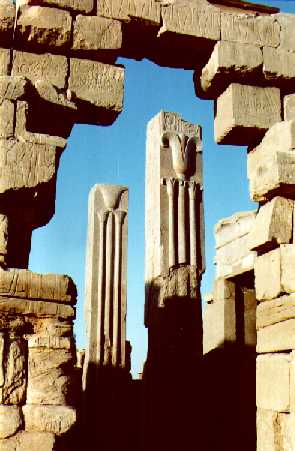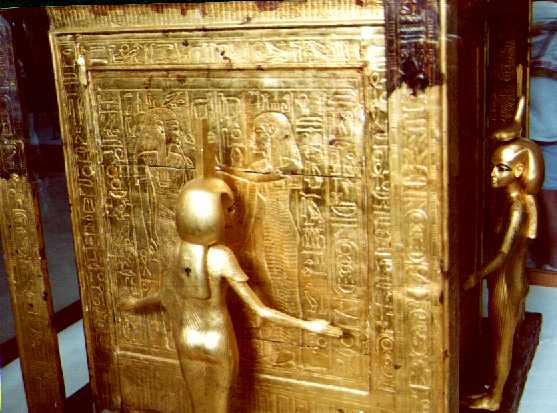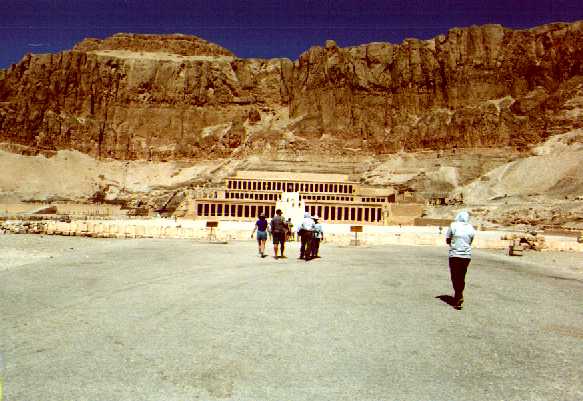
 |
Luxor, Egypt |
The city of Al-Uqsur (Arabic, "The Palaces") is the modern decedent of Thebes, the capital of the Ancient Egypt's New Kingdom 1650-1551 BCE. Here in Upper Egypt, some 550 km south of Cairo, or Memphis as it was known then, Ramses II and numerous other pharaohs ruled the Egyptian empire.
 The
archeological sites in Luxor include not only tombs and memorial temples
to the dead, but also temples and religious centers that served the needs
of the living in Ancient Egypt. In the temples of the living sacrifices
and prayers would be offered to the vast pantheon of Egyptian gods and
goddesses the most prominent of these was Amon Ra, the sun god. Only
slightly less important was the pharaoh, himself believed to be a god.
A large temple still stands in Luxor itself, but the most impressive site
is the enormous complex of the Temple of Karnak. Karnak encompasses
at least 7 separate temples dedicated to Amon Ra, his wife Mut, the moon
god Khons, and Montu the god of war.
The
archeological sites in Luxor include not only tombs and memorial temples
to the dead, but also temples and religious centers that served the needs
of the living in Ancient Egypt. In the temples of the living sacrifices
and prayers would be offered to the vast pantheon of Egyptian gods and
goddesses the most prominent of these was Amon Ra, the sun god. Only
slightly less important was the pharaoh, himself believed to be a god.
A large temple still stands in Luxor itself, but the most impressive site
is the enormous complex of the Temple of Karnak. Karnak encompasses
at least 7 separate temples dedicated to Amon Ra, his wife Mut, the moon
god Khons, and Montu the god of war.
 The
vast complex was begun around 1800 BCE and was added to by nearly every
ruler of Egypt until the Roman Empire. At its height as many as 81,000
priests, guards and other peasants worked in the complex. Perhaps
the most impressive of the surviving ruins is Ramses II's Great Hypostyle
Hall made up of 134 massive columns 24m high spread out over a 103 x 171m
room. Each year great festivals were held where all the citizens
of the town would assemble for a two week festival of sacrifice and prayers
to Amon Ra.
The
vast complex was begun around 1800 BCE and was added to by nearly every
ruler of Egypt until the Roman Empire. At its height as many as 81,000
priests, guards and other peasants worked in the complex. Perhaps
the most impressive of the surviving ruins is Ramses II's Great Hypostyle
Hall made up of 134 massive columns 24m high spread out over a 103 x 171m
room. Each year great festivals were held where all the citizens
of the town would assemble for a two week festival of sacrifice and prayers
to Amon Ra.
When a pharaoh passed on to the next life, he would be buried in a great tomb. The pharaohs of the Middle Kingdom abandoned the ostentatious pyramids for smaller, secret underground tombs in the hopes of hiding their treasures with their bodies from the tomb robbers. Most of these were located in the Valley of the Kings, some distance away from the western bank of the Nile River. Many of these tombs were quite extensive, 100 m long, with dozens of rooms, false passages and anything else they could do to fool the robbers. The insides of these tombs were intricately decorated with paintings depicting the pharaohs deeds in life, his hopes life as a god in the next world, and prayers to the gods for a favorable judgment on the pharaoh's conduct in his last life.
 Despite
all these massive security measures, all of the pharaoh's tombs were broken
into and plundered, except one. The one pharaoh who kept his treasure
until the present day was the previously obscure King Tutankhamun.
Tutankhamun came to the throne at the age of 8. His rule was chiefly
noted for restoring the ancient religious beliefs and priesthood of Egypt
after his father Akhenaten attempted to impose a monotheistic religion
on his people. However, Tutankhamun's rule came to an end just 10
years later when he died unexpectedly at age 18. Because he died
at such a young age, no tomb worthy of a king was available and King Tutankhamun
was buried instead in a very small nobleman's tomb. Some time later,
his unremarkable resting place was buried under rubble unearthed during
the building of the nearby tomb of Ramses VI. Tutankhamun's place
in history was similarly buried in the political upheavals that followed
his rule. Thus it wasn't until the early 20th century that anyone
realized he had existed, and that his tomb had not been found.
Despite
all these massive security measures, all of the pharaoh's tombs were broken
into and plundered, except one. The one pharaoh who kept his treasure
until the present day was the previously obscure King Tutankhamun.
Tutankhamun came to the throne at the age of 8. His rule was chiefly
noted for restoring the ancient religious beliefs and priesthood of Egypt
after his father Akhenaten attempted to impose a monotheistic religion
on his people. However, Tutankhamun's rule came to an end just 10
years later when he died unexpectedly at age 18. Because he died
at such a young age, no tomb worthy of a king was available and King Tutankhamun
was buried instead in a very small nobleman's tomb. Some time later,
his unremarkable resting place was buried under rubble unearthed during
the building of the nearby tomb of Ramses VI. Tutankhamun's place
in history was similarly buried in the political upheavals that followed
his rule. Thus it wasn't until the early 20th century that anyone
realized he had existed, and that his tomb had not been found.
 In
November 1922, a dedicated American archeologist discovered the tomb and
its contents. King Tutankhamun, a relatively minor pharaoh, buried
in a small tomb of just 3 rooms had been buried with each of those rooms
filled floor to ceiling with artifacts of the highest artistic quality
nearly all of which were made of gold. King Tutankhamun himself was
buried wearing a golden mask which was placed three successively larger
golden coffins which were placed in four box like shrines. Today
nearly all of these dazzling items fill the top floor of the Egypt Museum
in Cairo, except for one coffin which allows King Tutankhamun one privilege
denied any of his fellow rulers. He can rest in his own tomb.
In
November 1922, a dedicated American archeologist discovered the tomb and
its contents. King Tutankhamun, a relatively minor pharaoh, buried
in a small tomb of just 3 rooms had been buried with each of those rooms
filled floor to ceiling with artifacts of the highest artistic quality
nearly all of which were made of gold. King Tutankhamun himself was
buried wearing a golden mask which was placed three successively larger
golden coffins which were placed in four box like shrines. Today
nearly all of these dazzling items fill the top floor of the Egypt Museum
in Cairo, except for one coffin which allows King Tutankhamun one privilege
denied any of his fellow rulers. He can rest in his own tomb.
 In
addition to the burial complexes a number of temples dedicated to the memory
of the past rulers of Egypt exist, one of the most impressive of these
is Deir El-Bahari dedicated to Queen Hatshepsut, who stole the throne from
her brother King Tuthmosis III and ruled as Pharaoh for several years.
In
addition to the burial complexes a number of temples dedicated to the memory
of the past rulers of Egypt exist, one of the most impressive of these
is Deir El-Bahari dedicated to Queen Hatshepsut, who stole the throne from
her brother King Tuthmosis III and ruled as Pharaoh for several years.
Separating the temples of the dead and the dwellings of the living is the River Nile, the highway between upper and lower Egypt, and truly the life of Egypt. On both sides of the immense river are green cultivated fields which produced abundant crops using the river's fertile soil. But travel more than a kilometer away and you find nothing but inhospitable desert.
| Grand Central Station | |
|---|---|
|
|
|